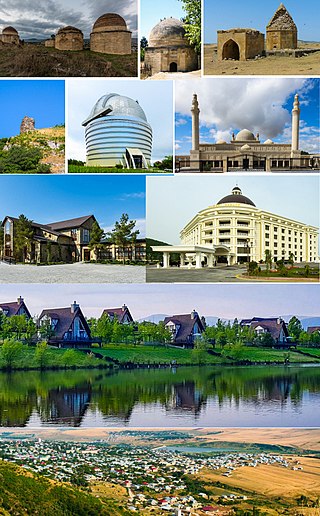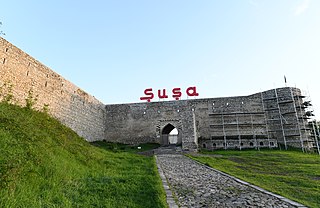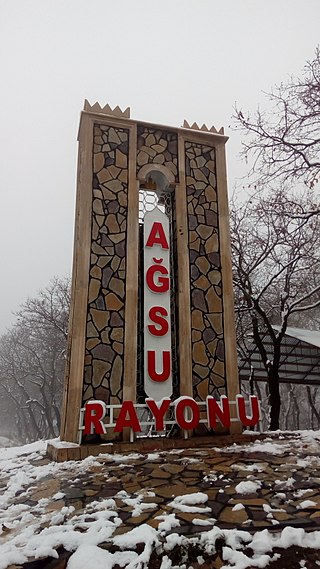
Shaki is a city in northwestern Azerbaijan, surrounded by the district of the same name. It is located on the southern part of the Greater Caucasus mountain range, 240 km (150 mi) from Baku. As of 2020, it has a population of 68,400. The center of the city and the Palace of Shaki Khans were inscribed in the UNESCO World Heritage List in 2019 because of its unique architecture and its history as an important trading center along the Silk Road.


The Palace of the Shirvanshahs is a 15th-century palace built by the Shirvanshahs and described by UNESCO as "one of the pearls of Azerbaijan's architecture". It is located in the Inner City of Baku, Azerbaijan and, together with the Maiden Tower, forms an ensemble of historic monuments inscribed under the UNESCO World Heritage List of Historical Monuments. The complex contains the main building of the palace, Divanhane, the burial-vaults, the shah's mosque with a minaret, Seyid Yahya Bakuvi's mausoleum, south of the palace, a portal in the east, Murad's gate, a reservoir and the remnants of a bath house. Earlier, there was an ancient mosque, next to the mausoleum. There are still ruins of the bath to the west of the tomb.
The Russo-Persian Wars or Russo-Iranian Wars were a series of conflicts between 1651 and 1828, concerning Persia (Iran) and the Russian Empire. Russia and Persia fought these wars over disputed governance of territories and countries in the Caucasus. The main territories disputed were Aran, Georgia and Armenia, as well as much of Dagestan – generally referred to as Transcaucasia – and considered part of the Safavid Iran prior to the Russo-Persian Wars. Over the course of the five Russo-Persian Wars, the governance of these regions transferred between the two empires. Between the Second and Third Russo-Persian Wars, there was an interbellum period in which a number of treaties were drawn up between the Russian and the Persian Empires, as well as between both parties and the Ottoman Empire. Ottoman interest in these territories further complicated the wars, with both sides forming alliances with the Ottoman Empire at different points throughout the wars. Following the Treaty of Turkmenchay, which concluded the Fifth Russo-Persian War, Persia ceded much of its Transcaucasian territory to the Russian Empire.

Shamakhi is a city in Azerbaijan and the administrative centre of the Shamakhi District. The city's estimated population as of 2010 was 31,704. It is famous for its traditional dancers, the Shamakhi Dancers, and also for perhaps giving its name to the Soumak rugs.
The architecture of Azerbaijan refers to the architecture development in Azerbaijan.

Shirvan Domes or Shamakhi mausoleum is a 15th-century mausoleum and graveyard in Shamakhi, Azerbaijan. It is located at the foot of Gulistan Fortress.

The Shusha fortress or Shushi fortress is a fortress surrounding the historical centre of Shusha, also called Shushi. Newly established castle town was called "Panahabad fortress" named after Panah Ali Khan who was the founder of the fort. In later years, the city was just called "Fortress". The name of Shusha was probably derived from a nearby Armenian village called Shosh or Shushikent.

Nizami Street is a large pedestrian and shopping street in downtown Baku, Azerbaijan, named after classical Persian poet Nizami Ganjavi.

Bukhara Caravanserai was erected in the late 15th century over a trade route passing through the Shamakhi Gates of the fortress. It is close to the Maiden Tower. The caravanserai was harnessed as a hotel, basically catering to merchants of Central Asia.

Baku Fortress is a medieval building in Baku, Azerbaijan, the largest of Absheron fortresses. The fortress consists of the Icheri Sheher and the walls and towers surrounding it and it was included by UNESCO into the World Cultural Heritage List in 2000. It was built in about 1138–1139 on the order of the Shirvanshah Manuchohr III (1120–1149).
Gulustan fortress is an ancient fortress in Goranboy region of Azerbaijan. The fortress is located at the foothills of Murovdag, bordering Agdere and Goranboy regions. It is encircled by precipice from eastern, western and southwestern sides, forest from the north side, and slope from the south-eastside. The fortress is situated on the coast of Incechay, at a height of 1700 m above sea level and 200–250 m above the nearby territory. The way to the fortress is from south-east. The length of the fortress is 200–250 m in the east–west direction and 20–25 m in the north–south direction. The width of the wall is 0.8–0.9 m in the north and west, and in the south wall it is 1.5 m. It is reported that there is also a secret road leading to the river.

The Palace of the Karabakh Khans or the Palace of Panah Ali Khan is a palace located in the historical center of the city of Shusha, the former residence of the founder of the Karabakh Khanate, Panah Ali Khan. During the reign of Panah Ali Khan, the palace was also the residence of the ruler where he lived together with his family. His son, Ibrahimkhalil Khan, together with his family and followers settled in the Palace of Ibrahimkhalil Khan built in the same period. For the eldest son of Ibrahimkhalil Khan, Mukhammedhasan Agha, another palace was built on a sheer cliff in the southeast of the Shusha plateau. In addition to these palaces, the Palace of the Khan's daughter, Natavan, and the Palace of Gara Boyuk khanim, belonging to the Khan's family, were also built in Shusha. Although in various sources the name of the Palace of the Karabakh Khan is attributed to each of these buildings, the main political residence of the Karabakh Khans was the palace-castle of the first Karabakh Khan, Panah Ali Khan.

The Salyan Gates are the gates located in the south-west of the fortress walls of Baku, in a garden near Azneft.

The Iravan Gate or the Khalfali Gate is one of the three main gates of the Shusha fortress, located in the western part of Shusha. The other two gates are: Ganja and Aghoghlan.

The Khan's Garden is a historical garden located in Icherisheher, being part of the Baku Khans Palace's complex. The Khan's Garden is located in the first courtyard of the palace in front of the house that belonged to the Khan's family. There is a small pool in the center of the garden. Also, on the territory of the garden, there is an ovdan and a tandir.

Divankhana Square or Bazaar-bashi is the first and the largest city square located at the entrance to Shusha, Azerbaijan from the side of the Ganja Gate. The largest shopping street Rasta Bazaar starts from this area.

















